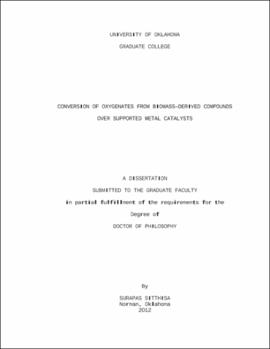| dc.contributor.advisor | Resasco, Daniel E | |
| dc.creator | Sitthisa, Surapas | |
| dc.date.accessioned | 2019-04-27T21:37:16Z | |
| dc.date.available | 2019-04-27T21:37:16Z | |
| dc.date.issued | 2012 | |
| dc.identifier | 99346381402042 | |
| dc.identifier.uri | https://hdl.handle.net/11244/319172 | |
| dc.description.abstract | The increasing consumption and phase-out of conventional fuels has caused the tremendous interest of our society in making use of renewable energy resources such as biomass. In response to this interest, bio-oil produced from biomass feed stocks has been gradually making its contribution as a part of normal fuels. However, since the bio-oil is not stable due to its high oxygen content, upgrading is necessary to improve its performance. Since the high oxygen content of bio-oils has limited its storage ability and lowered its heating content, in some cases, removing oxygen or deoxygenating bio-oil molecules has been proposed as a recommended catalytic reaction. However, the role of the bio-oil upgrading process is not only to eliminate oxygen, but also to retain carbon in the liquid, preferably by the cleavage of C-O bonds. In the scope of this dissertation, the author will present how a detailed knowledge of the nature of adsorbed species on different metal surfaces leads to tailored catalysts with the desired properties for conversion of oxygenates derived from bio-oils. | |
| dc.description.abstract | In the first part of the dissertation, the author will focus on the deoxygenation reaction of furfural, which can be derived from biomass feed stocks and contain the aldehyde functional group, on different monometallic catalysts. Within this context, copper, palladium and nickel catalysts have been selected to study their activity, selectivity, and possible reaction pathways. The study of the behavior of different metals may be useful in designing catalytic strategies towards the production of fuel components with specific characteristics. For the second part of the dissertation, bimetallic alloy catalysts have been used for the conversion of furfural. In this regard, the product with minimal reduction of carbon yield has been achieved. For example, monometallic Pd catalyst is highly active for decarbonylation of furfural by C-C bond cleavage yielding furan and CO as the dominant product. However, the addition of Fe to Pd forming Pd-Fe alloy, making the C-O bond cleavage more favorable, can dramatically change the product selectivity from furan to 2-methylfuran. | |
| dc.format.extent | 301 pages | |
| dc.format.medium | application.pdf | |
| dc.language | en_US | |
| dc.relation.requires | Adobe Acrobat Reader | |
| dc.subject | Biomass energy | |
| dc.subject | Catalysts | |
| dc.subject | Oxygenated gasoline | |
| dc.title | Conversion of Oxygenates from Biomass-Derived Compounds over Supported Metal Catalysts | |
| dc.type | text | |
| dc.type | document | |
| dc.thesis.degree | Ph.D. | |
| ou.group | College of Engineering::School of Chemical, Biological and Materials Engineering | |
